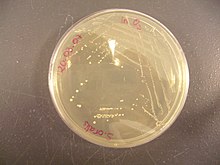Streptococcus oralis
| Streptococcus oralis | |
|---|---|

| |
| Scientific classification | |
| Domain: | Bacteria |
| Phylum: | Bacillota |
| Class: | Bacilli |
| Order: | Lactobacillales |
| Family: | Streptococcaceae |
| Genus: | Streptococcus |
| Species: | S. oralis
|
| Binomial name | |
| Streptococcus oralis Bridge and Sneath 1982[1]
| |
Streptococcus oralis is a
Individual cells of S. oralis are arranged into characteristic long chains when viewing
S. oralis is catalase negative and oxidase negative.[7] Strains of S. oralis produce neuraminidase and cannot bind α-amylase.[2][7][8] S. oralis is also acid-sensitive, producing alkaline metabolites to ameliorate its niche.[10]
Role in the oral microbiome
S. oralis is one of a few pioneer species important in early colonisation of the dental pellicle, where it establishes an eubiotic biofilm believed to be protective for
Opportunistic pathogenicity
S. oralis has been implicated in opportunistic cases of

Natural genetic transformation
Like other streptococci and oral commensals, S. oralis also shows high genetic diversity.[15] As such, it is competent for natural genetic transformation.[19] S. oralis cells are able to take up exogenous DNA and incorporate exogenous sequence information into their genomes by homologous recombination.[20] These bacteria can employ a predatory fratricidal mechanism for active acquisition of homologous DNA.[20]
References
- LPSN.
- ^ ISSN 0022-2615.
- ^ PMID 21413248, retrieved 2024-02-26
- PMID 29209465.
- ^ PMID 33690940.
- ^ a b "Streptococcus oralis". microbe-canvas.com. Retrieved 2024-02-26.
- ^ a b c d e f "ABIS Encyclopedia". tgw1916.net. Retrieved 2024-02-26.
- ^ a b c d "Streptococcus oralis - microbewiki". microbewiki.kenyon.edu. Retrieved 2024-02-26.
- ^ ISBN 978-0-387-30744-2, retrieved 2024-02-26
- ^ PMID 37275173.
- ^ PMID 38304711.
- PMID 37662325.
- ^ PMID 36949812.
- PMID 9423856.
- ^ PMID 19423627.
- PMID 8054434.
- ^ PMID 37009863.
- ISBN 978-0-12-801238-3, retrieved 2024-02-26
- PMID 21460080.
- ^ S2CID 30923996.
Note
- Marsh, Philip; Michael V. Martin (1999). Oral microbiology. Oxford [England]: Wright. ISBN 978-0-7236-1051-9.
External links
- Type strain of Streptococcus oralis at BacDive - the Bacterial Diversity Metadatabase
- Streptococcus oralis: Introduction, Morphology, Pathogenicity, Lab Diagnosis, Treatment, Prevention, and Keynotes at Universe84a
